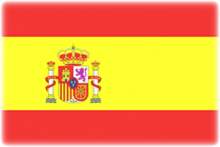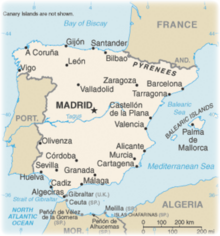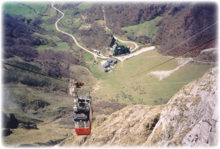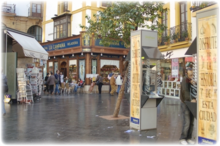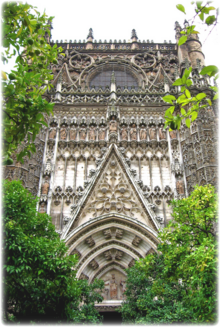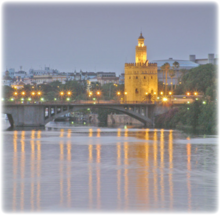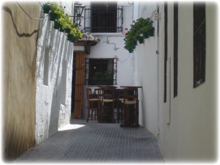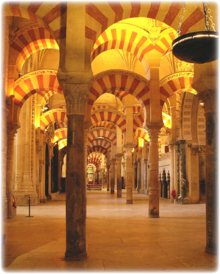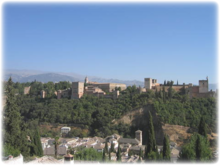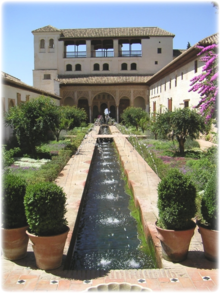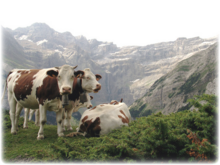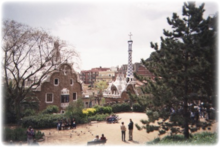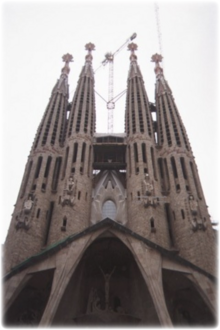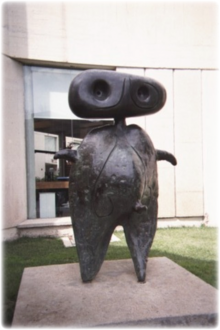
General Information
| Languages : | Castilian Spanish (official), Catalan, Galician |
| Currency : | Euro (EUR) |
| Time Zone : | EST +6hrs |
| Capital City : | Madrid |
| Population : | 40 Million |
| Government : | Parliamentary Monarchy |
| Total Area : | 194,897 mi² |
| Climate : | Temperate; clear, hot summers in interior, more moderate and cloudy along coast; cloudy, cold winters in interior, partly cloudy and cool along coast |
| National Holidays: | National Day, 12 October |
| Additional Info: | Diverse land; endless areas of wild sierra to explore, as well as spectacular rugged stretches of coast between the beaches. Almost every other village has a castle. |
Destination Activities
Activity Details
Hiking
Spain is such a beautiful country, so rich in culture, so alive with personality, and just so refreshing to visit. Taking the country on by foot is a really fantastic way to see more of its character than the regular backpacking tourist who soars past the countryside by train, oohing and aahing, but never really experiencing!
In the north of Spain, try heading to the oldest National Park in the country in the Picos de Europa mountain range. The park is shared by the provinces of Asturias, Cantabria and Leon. The highest point of the park is in Torrecerredo peak and the lowest point is in the Deva River, which is a vertical drop of 8,441ft. The Picos offer a wide range of walking opportunities (forest, valley, summer pasture and high mountains). You can enjoy both the meadow and alpine wildflowers blazing with color.
Basque Country and the Pyrenees - The Basque country is a cultural region in the western Pyrenees Mountains that spans the border between France and Spain. These hilly and coastal lands have been farmed, havens for shepherds and exploited for their mineral wealth for centuries and centuries by the Basque peoples who share a common language - Euskara. Euskara is a pre-Indoeuropean language and believed to date to the time when Cro-Magnons walked the earth some 40,000 years ago. Sample their world famous cuisine, visit their coastal fishing villages from, walk along their old smuggler's trails as you cross the border connecting France and Spain on two ancient Basque passes all the while being exhilarated by the most beautiful natural resources - the Urdaibai Biosphere Reserve on the coast, the densely forested Urkiola Nature Park, and the jagged Aizkorri range.
In the south of Spain, try some of the many hikes available in Andalusia. A 38-mile hike stretches out from Cordoba to Jaen running east through farmlands growing cereal and olive crops. The start of the path follows the Vereda de Granada, an old Roman way that connected the towns of Cordoba and Ategua. From a landscape and environmental viewpoint, the most interesting area on the path is the stretch running next to the River Guadajoz and its plain, as well as another area close to the Cerro Carrasco hill and El Jardon, where great bustards (large terrestrial birds mainly associated with dry open country and steppes in the Old World) can often be seen, a typical species of cereal farmland and currently in danger of extinction. The path runs through the municipalities of Cordoba, Espejo, Castro del Rio and Baena (Albendin).
In the province of Castellon, try the 36-mile hike, "Full Moon Path". A nice walk to take in 3 days, it starts in Castello de la Plana and ends at Sant Joan de Penyagolosa. The predominant landscape is made up of bushes, cropland and pine, holm oak and juniper forests. All of this forms an extremely varied landscape from the typical Mediterranean to that of the continent. Along the route are the chapel of Sant Vicent de Borriol, the Arabic castle of Borriol in Les Useres and, in the locality of Llucena, the former castle and now chapel of Sant Miquel de les Torrocelles. Xodos is located at an altitude of 1000m (3,280 ft) on the spurs of the Penyagolosa peak and surrounded by pine and kermes oak forests. The route ends in Sant Joan de Penyagolosa, a hermitage where pilgrimages converge every year from almost all of the surrounding villages. The GR 33 joins the GR 7 at the hermitage and, from here, here are 11 small circular routes (PR-V 64 to PR-V 74) starting and ending at the hermitage, which offer a general view of Penyagolosa and its surrounding area from the different routes.
Biking
Read a personal account of a 200-mile cycle trip in Andalucia
There are many, many cycling tour operators for Spain who will provide guided or self-guided tours (with luggage transport) around various regions of Spain. Below are some routes you could try on your own.
Try heading to Andalusia. A 300-mile (approximate) cycle trip will take you from From Granada through the Alpujarras, around the famous Sierra Nevada and along the Costa Tropical to Malaga. Expect to see some great views of mountains, olive- and orange-trees, semi-desert, forest, sea, beaches and, of course, sun.
Spanish fast trains don't take bikes making them pretty useless for cycle tourists. There is a network of slower regional trains, but they do not run too often and it takes meticulous planning in order to use them. As well, the highway planners often do not take bicyclists into account, so don't expect directional signs if the road unexpectedly turns into an expressway. So, make sure you bring up-to-date Michelin maps.
In the northeast of Spain, try the Catalonia region: Stay overnight in B&B farmhouses and travel through the countryside. Pedaling through the Girona area of Spain is remarkable for its archaeological importance as this route passes by the famous ruins of Empuries and the ancient Iberian settlement of Ullastret. Another important town is La Bisbal d'Emporda with its castle and ceramic tradition. Figueres, the capital of Alt Emporda has the Dali museum and in Banyoles there is the lake which is the biggest in the region. The Natural Park of the Marshes is an important and protected ornithological site.
Climbing
Interestingly, a great place to rest before or after mountaineering is Barcelona in the northeast of Spain. It is a picturesque location with its backdrop of lofty mountains and its beautiful coastline. The Pyrenees range are the natural boundary between France and Spain and is conveniently pass by the famous city. Although the main Pyrenees summits can be reached with basic climbing skills, the mountains have technical routes as demanding as any elsewhere.
Another popular and spectacular mountain range for climbers is the Sierra Nevada. The Sierra Nevada, meaning "snowy range" in Spanish, is a mountain range in the region of Andalusia. It contains the highest point of continental Spain, Mulhacen at 3,479m (11,414ft). There are many possible locations for climbing in this area. There are several mountaineering clubs and some challenging rock faces, particularly around the area of El Chorro, near Alora. Sierra de las Nieves, between Ronda and Malaga or Sierra Almijara are also popular with climbers. Other suggested areas for climbing are; Subetica Cordobes, Sierra de Grazalema, Sierra Magina in Jaen, Sierra Filambres and Sierra Maria in Almeria.
Cultural Information - Visiting Andalusia
Andalusia is home to Sevilla, Granada, Cordoba, as well as flamenco, white villages, tapas and olives. Here you can discover historic cities, world heritage monuments such as the Alhambra and Mezquita, whilst viewing Spain's stunning scenery. This region has been invaded or inhabited by many before you contemplated traveling there, including: Tartessians and Phoenicians, Carthaginians and Romans, Vandals and Visigoths, and of course, the Arabs and Moors.
For this review, we are going to start in Seville, a place this writer has been to for a short period of time only and is dying to return to.
Seville (Sevilla, when you are there)
Seville is the artistic, cultural, and financial capital of southern Spain. It is the capital of Andalusia and of the province of Sevilla. Seville is more than two thousand years old. The passage of the various people instrumental in its growth has left the city with a distinct personality, and a large and well-preserved historical center.The climate of Seville is Mediterranean, with oceanic influences. The annual average temperature is 65degF, which makes this city one of the warmest in Europe.
Taken from Andalusia.org, nothing says it better about Seville:
Impossible to find another urban center which boasts such varied and unusual monuments and places of such beauty as the Giralda, the Cathedral, Los Reales Alcazares (Arabic Palace), the Torre del Oro, the Patio de los Naranjos, the Maestranza (bull-ring), the Casa de Pilatos, the Plaza de Espana, the Maria Luisa Park, the Maestranza theatre, the St. Telmo Palace, the Archivo de las Indias (Indian Archives),the Barrio de Santa Cruz (Santa Cruz district in the city centre), the Lonja, the Palacio Arzobispal (Archbishop´s Palace), the Fabrica de Tabacos (Tabacco Factory), the Town Hall (Town Hall), the Duenas Palace, the D.Fadrique tower, the city walls, the Macarena basilica, the Fine Art Museum, the Contemporary Art museum, the Alameda de Hércules, the barrio de Triana (Triana district), the bridges over the Guadalquivir, the Cartuja island and monastery and the site of Expo 92, the buildings from the Universal exhibition in 1929, the Casa de Luca de Tena, the patios of its traditional houses, the balconies and railings, as well as an endless number of churches, convents and other details which convert the ancient city center into an open-air museum. If we add to this its taverns, its cuisine, its festivals, and the humor and hospitality of its people, we have formed a generous whole, full of color, drama, light, music, joy, tradition and modernity which is difficult to match.
The Cathedral of Seville, formally Catedral de Santa MarÃa de la Sede (Cathedral of Saint Mary of the See) was begun in 1402, with construction continuing into the 16th century. It is the largest of all Roman Catholic cathedrals and also the largest Medieval Gothic religious building, in terms of both area and volume. Its central nave rises to an awesome 138ft and even the side chapels seem tall enough to contain an ordinary church. Its main altarpiece is considered the largest in the Christian world. During the planning of the cathedral's construction, a member of the chapter was recorded to have commented "we shall have a church [so great and] of such a kind that those who see it built will think we were mad."
The Alcazar of Seville (Spanish "Alcazares Reales de Sevilla") is a royal palace. Originally a Moorish fort, the Alcazar has been expanded several times. Most of the modern Alcazar was built over Moorish ruins for King Pedro of Castile (also known as Pedro the Cruel) with construction beginning in 1364. Pedro used Moorish workers to build his palace giving it a distinctly Islamic design. The palace is one of the best remaining examples of mudejar architecture, a style under Christian rule in Spain but using Islamic architectural influence.
The Torre del Oro (Spanish for "Gold Tower") is a military watchtower built during the Almohad dynasty in order to control access to the city via the Guadalquivir river. The tower was built as part of the defensive works running from the Alcazar to the river. The tower may have received its name from the golden tiles which cover its dome and may have once adorned the rest of the tower.
The Plaza de Espana is one of Seville's most easily recognized buildings and the epitome of the Moorish Revival in Spanish architecture. In 1929 Seville hosted the Spanish-American Exhibition and numerous buildings were constructed for the exhibition in Maria Luisa Park, among them the Plaza. On the Park's edge was built the current Plaza de Espana to showcase Spain's industry and technology exhibits. I came across this place on a rushed night of quick tourism before catching a late train, and I loved it - the tile work, the little details in the architecture. How I wish I had my digital camera back then.
The Plaza is a huge half-circle with buildings continually running around the edge accessible over the moat by numerous beautiful bridges . In the center is a large fountain. Today the plaza mainly consists of Government buildings, but the beauty remains. A popular way to view the exhibition is by renting out a rowing boat and drifting around the moat. By the walls of the Plaza are many tiled alcoves, each representing a different province of Spain. Tourists can have their photo taken by their own home province.
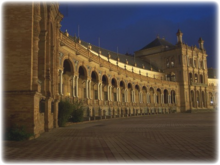
Cordoba
Today a moderately-sized modern city, the old town contains many impressive architectural reminders of when Cordoba was the thriving capital of the Caliphate of Cordoba that governed almost all of the Iberian peninsula. It is a city of immense monumental wealth with art and history to be found in every alleyway, patio and square. The city is best known for its Mosque, a unique building which tells of the splendor of this one-time Caliphate, but don't forget the Cathedral, the Fortress of the Christian Monarchs (Alcazar de los Reyes Cristianos), the Roman Bridge and the Albolafia, La Calahorra Tower, the Jewish Quarter, the patios, El Potro Square and the myriad of other charms and locations that this, one of the country's most interesting and beautiful cities, has to offer.
The Mezquita (Spanish for "mosque") is a Roman Catholic cathedral. It was originally built to be a warehouse/temple/lighthouse. It later became the second-largest mosque in the world. Come on - you must remember this one from art class?? The construction of the Mezquita started in approximately 6th Century BCE. Later, the Mezquita (originally the Aljama Mosque) was reworked for over two centuries to refashion it as a mosque, starting in 784 AD. It underwent many other changes in its life. It was the most magnificent of the more than 1,000 mosques in the city and was at one time the second largest mosque in the Muslim world. It was connected to the Caliph's palace by a raised walk-way. Mosques within the palaces being the tradition for the Islamic rulers of all times. The year that Cordoba was recaptured from the Moors and rejoined Christendom, the mosque was reconsecrated a Christian church. Additoins and changes continued to be constructed. The most significant alteration was the construction of a Renaissance cathedral nave in the middle of the structure. Artisans and architects continued to add to the existing structure until the late 18th century.
And if you love Gazpacho, this is the place to come to try it out - specialties of the town include: Gazpacho andaluz (chilled tomato, garlic and vegetable soup). Gazpacho blanco (chilled garlic and vegetable soup). Salmorejo (thick chilled tomato soup with garlic, pepper, bread and egg).
Granada
Granada is situated at the foot of the Sierra Nevada mountains, at the confluence of two rivers, Darro and Genil, at an elevation of 2,421ft above sea level. Its hard to briefly describe the city's history, like many of the towns in Andalusia: There was an Ibero-Celtic settlement here, which made contact in turn with Phoenicians, Carthagenians and Greeks. Under Roman rule, in the early centuries CE, this name had become "Illiberis". As Illiberis, the city minted its own coins. The Visigoths maintained the importance of the city as a center of both ecclesiastical and civil administration and also established it as a military stronghold. A Jewish community established itself in what was effectively a suburb of the city, called "Garnata" or "Garnata al-yahud" (Granada of the Jews). It was with the help of this community that Moorish forces under Tariq ibn-Ziyad first took the city. And on it went...
The Alhambra, a Moorish citadel and palace, is in Granada. It is one of the most famous items of the Muslim, Jewish, and Christian historical legacy that makes Granada a hot spot among cultural and tourist cities in Spain. Alhambra, signifying in Arabic the red, derives from the color of the red clay of the surroundings of which the fort is made. The buildings of the Alhambra were originally whitewashed; however, the buildings now seen today are reddish. Moorish poets described it as "a pearl set in emeralds," in allusion to the brilliant color of its buildings, and the luxuriant woods round them. The park (Alameda de la Alhambra) was planted by the Moors with roses, oranges and myrtles; its most characteristic feature, however, is the dense wood of English elms brought there in 1812 by the Duke of Wellington. The park is celebrated for the multitude of its nightingales, and is usually filled with the sound of running water from several fountains and cascades.
Photography
If you have adventure-travel related experience in this region and would like to add content to this page, please contact us to learn how.
|
|||||||
